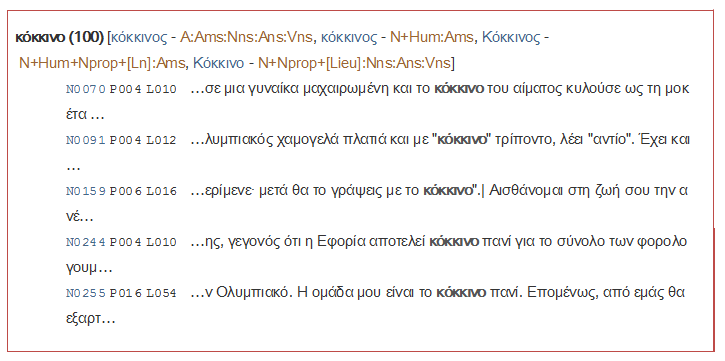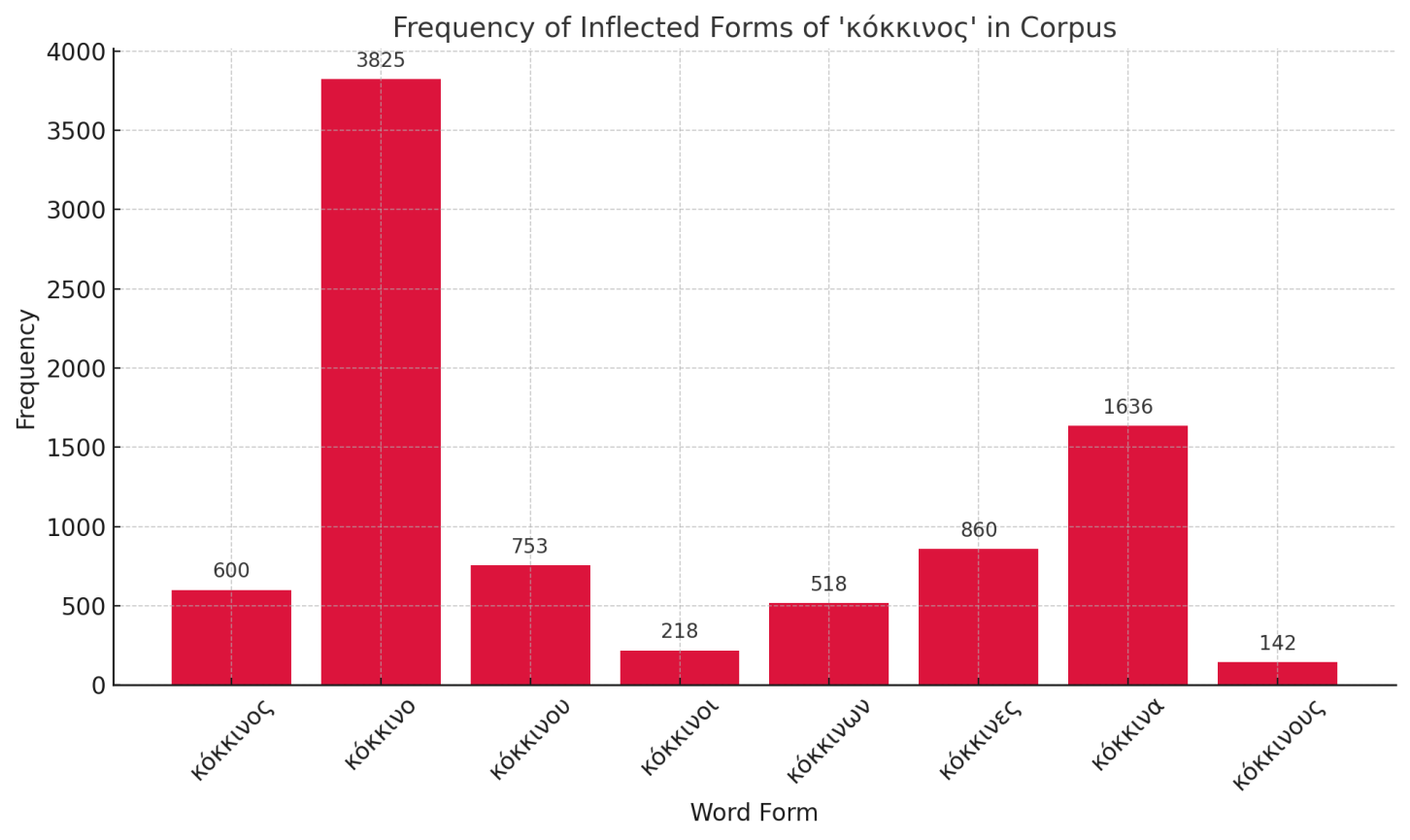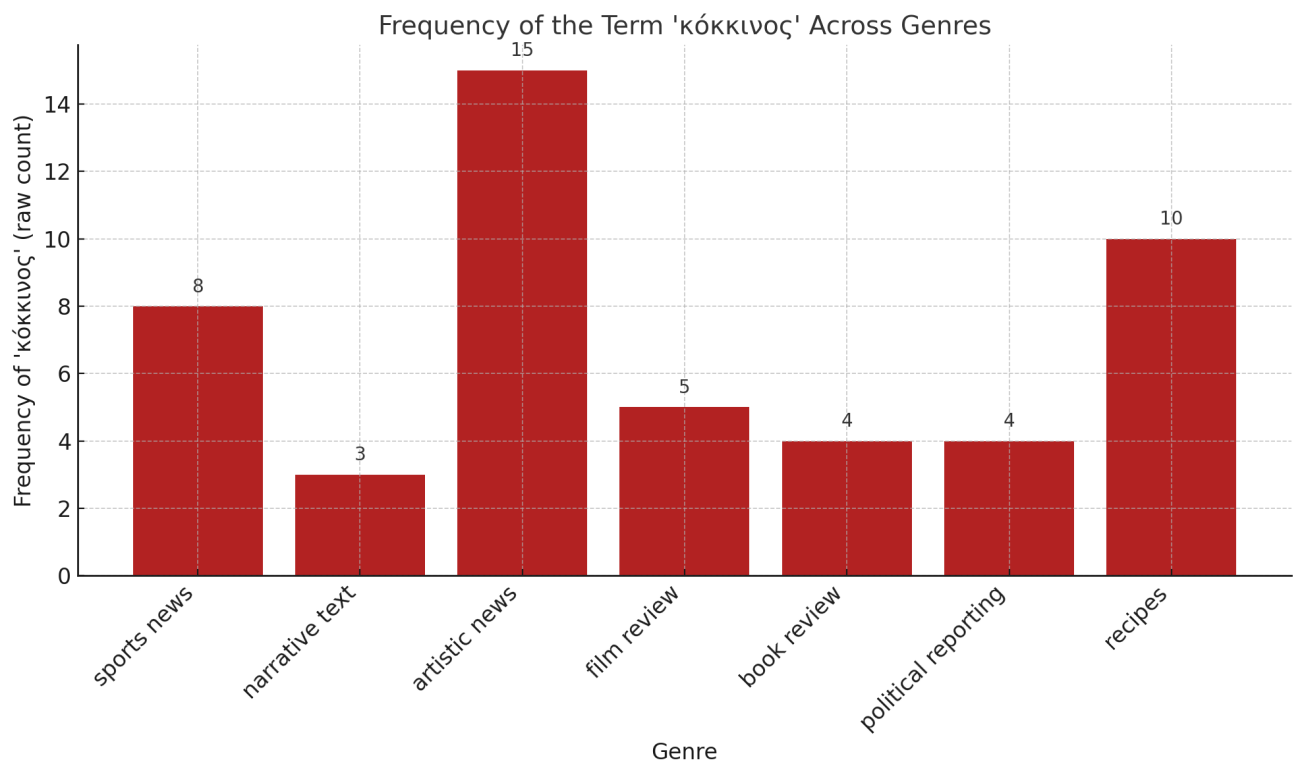Semantics in corpus linguistics: the basic colour term red in Modern Greek
This paper argues that electronic corpora provide a rich source of data and a useful tool for semantics. More specifically, collocations, semantic preference and semantic prosody of the basic colour term kókkinos ("red") in Modern Greek are examined, using text corpora, such as Greek electronic dictionaries, SEK (Corpus of Greek texts) and Educational Thesaurus of Greek Texts. The results of the research show that such a corpus-based analysis reveals the semantic and pragmatic aspects of language, the linguistic expression of emotion concepts, through conceptual metaphor and metonymy. Collocations with this term seem to reveal a high degree of semantic opacity in the framework of conceptual metaphor. In addition, kókkinos (red) is mainly related to negative semantic prosody, denoting for instance prohibition (kókini zóni = red zone, i.e. the area where entry is prohibited), danger/emergency (kókinos sinaγermós = red alert), prostitution/immorality kókino fotáki (= red light in a tolerance house) and negative emotions such as anger (kókinos san astakós = as red as a lobster), sorrow (kókini traγoδíα = red tragedy) and shame (égine kókinos san pantzári (= He turned as red as beetroot). The originality of the research lies in the emergence of the power of context and contextual factors in linguistic analysis, using naturally occurring instances and precise corpus techniques. Regarding the study limitations, the analysis is based on a specific set of corpora (Greek electronic dictionaries, SEK, and Educational Thesaurus of Greek Texts), which, while valuable, may not represent the full diversity of language use in informal, spoken, or contemporary digital contexts (e.g., social media, forums).
Figures





Serakioti, D. (2025). Semantics in corpus linguistics: the basic colour term red in Modern Greek, Research Result. Theoretical and Applied Linguistics, 11 (3), 122–134.


















While nobody left any comments to this publication.
You can be first.
Babanoğlu, M. K. (2015). A corpus-based study on the use of feelings and emotions vocabulary by male and female EFL learners, International Journal of Language and Linguistics, 3 (4), 203–209. https://doi.org/10.11648/j.ijll.20150304.12(In English)
Barnbrook, G., Mason, O. and Krishnamurthy, R. (2013). Collocation: Applications and implications, Palgrave Macmillan, Houndmills, Basingstoke and New York. (In English)
Bednarek, M. (2008). Semantic preference and semantic prosody re-examined, Corpus Linguistics and Linguistic Theory, 4 (2), 119–139. (In English)
Bellizzi, J. A. and Hite, R. E. (1992). Environmental color, consumer feelings, and purchase likelihood, Psychology & Marketing, 9 (5), 347–363. https://doi.org/10.1002/mar.4220090502(In English)
Benczes, R. and Tóth-Czifra, E. (2014). The Hungarian colour terms piros and vörös: A corpus and cognitive linguistic account, Acta Linguistica Hungarica, 61 (2), 123–152. (In English)
Bennett, T. J. A. (1988). Aspects of English Colour Collocations and Idioms, Carl Winter Universitätsverlag, Heidelberg, Germany. (In English)
Berlin, B. and Kay, P. (1969). Basic Color Terms: Their Universality and Evolution, University of California Press, Berkeley, USA. (In English)
Biber, D., Conrad, S. and Reppen, R. (1998). Corpus linguistics: Investigating language structure and use, Cambridge University Press, New York, USA. (In English)
Brosa-Rodríguez, A. and Jiménez-López, M. D. (2023). Quantifying basic colors’ salience from cross-linguistic corpora, Color Research & Application, 49 (1), 34–50. https://doi.org/10.1002/col.22899 (In English)
Conrad, S. (2010). What can a corpus tell us about grammar? in McCarthy, M. J. and O’Keeffe, A. (eds.), Routledge Handbook of Corpus Linguistics, Routledge. (In English)
Dai, S. and Zainal, A. Z. (2025). An Empirical Study of Basic Color Terms in Chinese. Forum for Linguistic Studies, 7 (5), 861–872. https://doi.org/10.17507/tpls.1509.05(In English)
Dunn, J. (2022). Natural Language Processing for Corpus Linguistics, Cambridge University Press, Cambridge, UK. (In English)
Elliot, A. J., Maier, M. A., Moller, A. C., Friedman, R., and Meinhardt, J. (2007). Color and psychological functioning: The effect of red on performance attainment, Journal of Experimental Psychology: General, 136 (1), 154–168. https://doi.org/10.1037/0096-3445.136.1.154(In English)
Goutsos, D. (2003). Corpus of Greek texts: Planningand materialization, Proceedings of the 6th International Conference of Greek Linguistics, University of Crete, Greece, CD-ROM publication. (In English)
Gries, S. Th. (2009). What is corpus linguistics? Language and Linguistics Compass, 3, 1–17. https://doi.org/10.1111/j.1749-818X.2009.00149.x(In English)
Hamilton, R. L. (2016). Colour in English: from metonymy to metaphor, Ph.D. Thesis, University of Glasgow, Scotland, UK. (In English)
Hemming, J. (2012). Red, White, and Black in Symbolic Thought: The Tricolour Folk Motif, Colour Naming, and Trichromatic Vision, Folklore, 123 (3), 310–329. http://www.jstor.org/stable/41721562(In English)
Hunston, S. (2007). Semantic Prosody Revisited, International Journal of Corpus Linguistics, 12, 249–268. https://doi.org/10.1075/ijcl.12.2.09hun(In English)
Kalda, A. and Uusküla, M. (2019). The role of context in translating colour metaphors: An experiment on English into Estonian translation, Open Linguistics, 5, 690–705. (In English)
Kennedy, G. (2014). An introduction to corpus linguistics, Routledge, London, UK. (In English)
Lakoff, G. and Johnson, M. (1980). Metaphors we live by, University of Chicago Press, Chicago, USA.
Lévi-Strauss, C. (1963). Structural anthropology, translated by C. Jacobson and B. G. Schoepf, Basic Books, NY, USA. (In English)
Lakoff, G. (1993). The contemporary theory of metaphor, in Ortony, A. (Ed.), Metaphor and thought, 2nd ed., Cambridge University Press, 202–251. (In English)
Lüdeling, A. and Kytö, M. (eds.) (2008). Corpus Linguistics: An international handbook, Walter de Gruyter, Berlin, Germany. (In English)
MacLaury, R. E., Almási, J. and Kövecses, Z. (1997). Hungarian piros and vörös: color from points of view, Semiotica, 114 (1/2), 67–81. (In English)
McCarthy, M. (2006). Explorations in Corpus Linguistics, Cambridge University Press, Cambridge, UK. (In English)
Oster, U. (2010). Using corpus methodology for semantic and pragmatic analyses: What can corpora tell us about the linguistic expression of emotions? Cognitive Linguistics, 21 (4), 727–763.
Oster, U. (2012). “Angst” and “fear” in contrast: A corpus-based analysis of emotion concepts, in Brdar, M., Raffaelli, I. and Fuchs, M. (eds.), Cognitive linguistics between universality and variation, Cambridge Scholars Publishing, Newcastle, UK, 327–354. (In English)
Philip, G. (2011). Colouring Meaning. Collocation and connotation in figurative language, John Benjamins, Amsterdam/Philadelphia, Netherlands. (In English)
Russnes, M. (2024). Semantic prosody, semantic transfer and semantic change, ICAME Journal, 48(1), 67–88. (In English)
Serakioti, D. (2020). Quantifying Semantics Using Statistical Tools: An Empirical Research in Colour Compounds in Modern Greek, European Scientific Journal, 16 (23), 185–205. (In English)
Serakioti, D. (2021). Semantic analysis of the color terms áspros/lefkós (white) and mávros (black) in Modern Greek, Proc.13th International Conference on Greek Linguistics, University of Patras, Patras, Greece. (In Greek)
Serakioti, D. and Stefaneas, P. (2022). Ambiguity in Argumentation: The Impact of Contextual Factors on Semantic Interpretation. Studia Humana, 11 (3–4), 18–24. https://doi.org/10.2478/sh-2022-0012 (In English)
Sinclair, J. (2005). Corpus and Text. Basic Principles, in Wynne, V (ed.), Developing Linguistic Corpora: A Guide to Good Practice, Oxbow Books, Oxford, UK, 1–16. http://hdl.handle.net/20.500.14106/dlc(In English)
Sinclair, J. M. (1991). Corpus, concordance and collocation, Oxford University Press, Oxford, UK. (In English)
Stefanowitsch, A. (2006). Corpus-based approaches to metaphor and metonymy, in Stefanowitsch, A. and Gries, S. T. (eds.), Corpus-based approaches to metaphor and metonymy, Mouton de Gruyter, Berlin & New York, Germany & USA, 1–16. (In English)
Steinvall, A. (2006). Basic Colour Terms and Type Modification: Meaning in relation to function, salience and correlating attributes, Progress in Colour Studies: Volume I. Language and Culture, 57–71. (In English)
Stubbs, M. (1996). Text and Corpus Analysis, Computer-assisted Studies of Language and Culture, Blackwell, Oxford, UK. (In English)
Stubbs, M. (2001). Words and Phrases: Corpus Studies of Lexical Semantics, Blackwell, Oxford, UK. (In English)
Theodoropoulou, M. (2012). The emotion seeks to be expressed: Thoughts from a linguist’s point of view, in Chaniotis, A. (ed.), Unveiling emotions: Sources and methods for the study of emotions in the Greek world, Steiner, Stuttgart, Germany, 433–468. (In English)
Tsapakidou, K. (2015). Emotion and feeling in emotion talk, M.A. Thesis, Department of Linguistics, School of Philology, Aristotle University of Thessaloniki, Greece. (In English)
Vaňková, I. (2007). To have color and to have no color. The coloring of the face in the Czech linguistic picture of the world, in MacLaury, R. E., Paramei, G. V. and Dedrick, D. (eds.), Anthropology of color: Interdisciplinary multilevel modeling, John Benjamins, Amsterdam/Philadelphia, Netherlands, 441–456. (In English)
Wang, S. and Yao, Y. (2025). The Semantic Evolution and Cultural Cognition of the English Basic Color Term ‘Green’ — A Diachronic Analysis Based on Cognitive Anthropology, Nature Anthropology, 3 (3), 10013-10013.